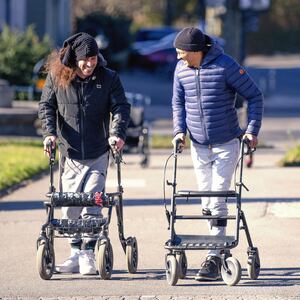Multiple system atrophy (or MSA), is a pretty rare neurodegenerative disease, but its impact is devastating for the unlucky 50,000 adult patients who are afflicted in the U.S. Symptoms usually appear once a person is in their fifties. Over the next five to 10 years, patients lose control of nearly all their muscles and some experience a dangerous drop in blood pressure when they try standing or moving—called orthostatic hypotension. People with MSA ultimately lose the ability to move their bodies at all.
Until now. In a new study published April 6 in the New England Journal of Medicine, Swiss researchers describe an electronic spinal cord implant that helped a woman bedridden by MSA walk again.
“We’ve already seen how this type of therapy can be applied to patients with spinal cord injury,” said Jocelyne Bloch, a neurosurgeon at Lausanne University Hospital in Switzerland and co-author of the study, in a press release. “But now, we can explore applications in treating deficiencies resulting from neurodegeneration. This is the first time we’ve been able to improve blood-pressure regulation in people suffering from MSA.”
Bloch and her team previously used their device to successfully activate nerves involved in movement in people with spinal cord injuries. For the woman in this latest study, who suffered from a specific type of MSA (MSA-P) that causes symptoms similar to Parkinson’s disease, the implant was instead used to correct her orthostatic hypotension.
The nervous system usually directs blood vessels in the lower body to deliver oxygenated blood by raising blood pressure. MSA-P’s degradation of the nervous system prevents those messages from going through. Patients tend to faint without ever being able to get up. The woman in the new study had been bedridden for 18 months because of fainting spells.
The new implant, placed directly on the patient’s spinal cord, reverses this problem by firing electrical signals that reactivate those nerves that control and regulate blood pressure during movement. When activated, the implant allowed the woman with MSA-P to stand up almost immediately, and she eventually worked up the strength to walk a distance equivalent to about two-and-a-half football fields using a walker.
While this electronic implant is a game-changer for patients suffering from MSA-P and potentially other diseases where patients have limited mobility because of neurological disorders or nerve damage, it isn’t a cure. And its clinical benefits have only been observed in one patient.
The results “must be interpreted with extreme caution, as [this] was a single case, without any type of blinding or control group, so there is a high possibility of bias,” Dr. Jose-Alberto Palma, a neurologist at New York University Grossman School of Medicine, told LiveScience in an email. It’s also important to note that, although the implant has improved the patient’s quality of life, it does not address her underlying neurodegenerative disease, which is fatal, he said.
That said, Bloch and her team are planning ongoing studies to create a commercially available device for MSA patients.
“This technology was initially intended for pain relief, not for this kind of application,” Grégoire Courtine, a neuroscientist at the École Polytechnique Fédérale de Lausanne and co-author of the study, said in a press release. “Going forward, we and our company Onward Medical plan to develop a system targeted specifically to orthostatic hypotension that can help people around the world struggling with this disorder.”








